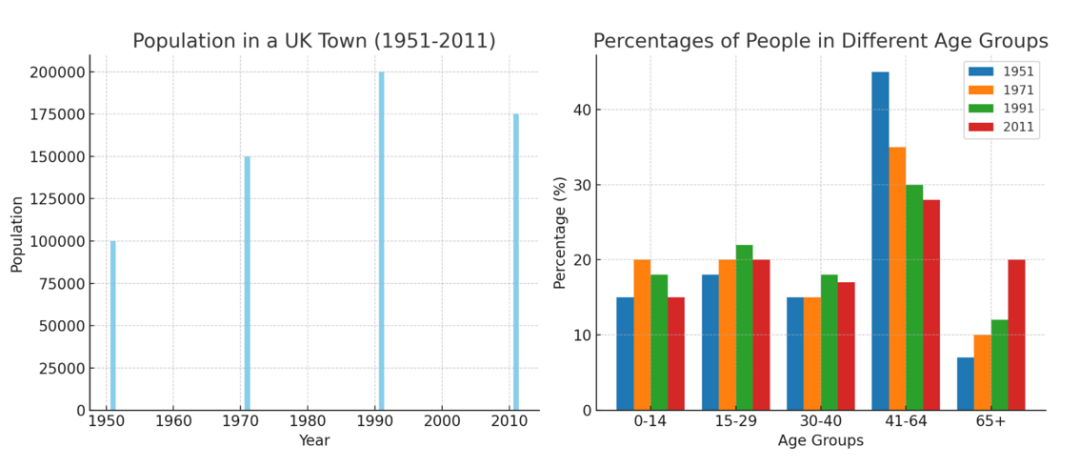01、雅思听力
Listening
Part1 瑜伽课程
【题型】:填空题
点评
该篇part1 难度较易。答题时注意字母、数字拼写题目的细节,熟悉各类常见拼写考点的念法。
1.injuries
2.Tuesday
3.children
4.actor
5.7.15
6.bus
7.0287634865
8.Murray
9.café
10.sugar
(答案仅供参考,实际答案及顺序可能有变化)
Part2 旅游介绍
【题型】:单选+配对
点评
旅游场景也为part2常考话题,对于各位同学来讲都不陌生,场景熟悉的情况下,更要关注题干的限定和选项的细节。
Part3 教师培训
【题型】:单选+配对
点评
场景上涉及较多的教育专业词汇和术语,同学们需要提前熟悉这类词汇,否则可能会影响对听力材料的理解。配对题需要在听的过程中做好笔记,理清信息之间的逻辑关系,多关注转折、因果等逻辑连接,避免被冗余信息干扰。
Part4 蜜蜂
【题型】:填空
点评
话题为常规动植物话题,其中mud(泥土)为B2等级词汇,其余均为较基础的单词。同学们书写时要注意根据语法搭配推测单复数。
31. cave
32. temple
33. wood
34. medicine
35. weather
36. mud
37. legs
38. vegetables
39. skin
40. cooking
(答案仅供参考,实际答案及顺序可能有变化)
02、雅思阅读
Reading
三篇文章主题分别为非洲传统农业系统、婴儿语言、罗马,题型涵盖填空、配对、判断、单选等,整体难度适中,侧重考查细节定位与逻辑理解能力,passage1继上周高难度组合后,再次出现复杂题型组合模式。
Passage 1
主题:Traditional Farming System in Africa
题型:填空(4个)+配对(4个)+判断(4个)+单选(1个)
类别:科技
难度:★★
填空题
1. need
2. (the) ashes
3. (vegetable) cassava
4. houses
配对题
5. C
6. B
7. A
8. A
判断题
9. TRUE
10. NOT GIVEN
11. FALSE
12. TRUE
单选题
13. B
点评
P1文章聚焦非洲卢阿普拉地区的传统农业系统,核心围绕“citemene”(轮垦制)展开,涉及土地分配、作物种植、性别分工、渔业与农业的关系等内容。从题型来看,包含填空题(1-4题)、分类题(5-8题)、判断题(9-12题)及单选题(13题),覆盖雅思阅读常见基础题型,侧重考查细节定位、同义替换及逻辑理解能力。
文章以“传统农业系统—性别分工—替代种植方式—渔业与农业互补—生态挑战”为逻辑主线,属于雅思阅读常考的“社会科学+生态环境”交叉主题。类似话题在过往考试中曾涉及“原住民农业智慧”“传统生态系统可持续性”等,考生需积累相关词汇(如“subsistence farming”“agroforestry”“soil depletion”)。
参考文章:
READING PASSAGE 1
You should spend about 20 minutes on Questions 1-13 which are based on Reading Passage 1 below.
Traditional Farming System in
Africa
A
By tradition land in Luapula is not owned by individuals, but as in many other parts of Africa is allocated by the headman or head woman of a village to people of either sex, according to need. Since land is generally prepared by hand, one ulupwa cannot take on a very large area; in this sense, the land has not been a limiting resource over large parts of the province. The situation has already changed near the main townships, and there has long been a scarcity of land for cultivation in the Valley. In these areas registered ownership patterns are becoming prevalent.
B
Most of the traditional cropping in Luapula, as in the Bemba area to the east, is based on citemene, a system whereby crops are grown on the ashes of tree branches. As a rule, entire trees are not felled but are pollarded so that they can regenerate. Branches are cut over an area of varying size early in the dry season and stacked to dry over a rough circle about a fifth to a tenth of the pollarded area. The wood is fired before the rains and in the first year planted with the African cereal finger millet (Eleusine coracane).
C
During the second season, and possibly for a few seasons more the area is planted to variously mixed combinations of annuals such as maize, pumpkins (Telfiria occidentalis) and other cucurbits, sweet potatoes, groundnuts, Phaseolus beans and various leafy vegetables, grown with a certain amount of rotation. The diverse sequence ends with vegetable cassava, which is often planted into the developing last-but-one crop as a relay.
D
Richards (1969) observed that the practice of citemene entails a definite division of labour between men and women. A man stakes out a plot in an unobtrusive manner since it is considered provocative towards one’s neighbours to mark boundaries in an explicit way. The dangerous work of felling branches is the men’s province and involves much pride. Branches are stacked by the women and fired by the men. Formerly women and men cooperated in the planting work, but the harvesting was always done by the women. At the beginning of the cycle little weeding is necessary, since the firing of the branches effectively destroys weeds. As the cycle progresses weeds increase and nutrients eventually become depleted to a point where further effort with annual crops is judged to be not worthwhile: at this point the cassava is planted, since it can produce a crop on nearly exhausted soil. Thereafter the plot is abandoned, and a new area pollarded for the next citemene cycle.
E
When the forest is not available – this is increasingly the case nowadays – various ridging systems (ibala) are built on small areas, to be planted with combinations of maize, beans, groundnuts and sweet potatoes, usually relayed with cassava. These plots are usually tended by women, and provide subsistence. Where their roots have year-round access to water tables mango, guava and oil-palm trees often grow around houses, forming a traditional agroforestry system. In season some of the fruit is sold by the roadside or in local markets.
F
The margins of dambos are sometimes planted to local varieties of rice during the rainy season, and areas adjacent to vegetables irrigated with water from the dambo during the dry season. The extent of cultivation is very limited, no doubt because the growing of crops under dambo conditions calls for a great deal of skill. Near towns, some of the vegetable produce is sold in local markets.
G
Fishing has long provided a much-needed protein supplement to the diet of Luapulans, as well as being the one substantial source of cash. Much fish has dried for sale to areas away from the main waterways. The Mweru and Bangweulu Lake Basins are the main areas of year-round fishing, but the Luapula River is also exploited during the latter part of the dry season. Several previously abundant and desirable species, such as the Luapula salmon or mpumbu (Labeo altivelis) and pale (Sarotherodon machochir) have all but disappeared from Lake Mweru, apparently due to mismanagement.
H
Fishing has always been a far more remunerative activity in Luapula that crop husbandry. A fisherman may earn more in a week than a bean or maize grower in a whole season. I sometimes heard claims that the relatively high earnings to be obtained from fishing induced an ‘easy come, easy go’ outlook among Luapulan men. On the other hand, someone who secures good but erratic earnings may feel that their investment in economically productive activity is not worthwhile because Luapulans fail to cooperate well in such activities. Besides, a fisherman with spare cash will find little in the way of working equipment to spend his money on. Better spend one’s money in the bars and have a good time!
I
Only small numbers of cattle or oxen are kept in the province owing to the prevalence of the tsetse fly. For the few herds, the dambos provide subsistence grazing during the dry season. The absence of animal draft power greatly limits peoples’ ability to plough and cultivate land: a married couple can rarely manage to prepare by hand-hoeing. Most people keep freely roaming chickens and goats. These act as a reserve for bartering, but may also be occasionally slaughtered for ceremonies or for entertaining important visitors. These animals are not a regular part of most peoples’ diet.
J
Citemene has been an ingenious system for providing people with seasonal production of high-quality cereals and vegetables in regions of acid, heavily leached soils. Nutritionally, the most serious deficiency was that of protein. This could at times be alleviated when fish was available, provided that cultivators lived near the Valley and could find the means of bartering for dried fish. The citemene/fishing system was well adapted to the ecology of the miombo regions and sustainable for long periods, but only as long as the human population densities stayed at low levels. Although population densities are still much lower than in several countries of South-East Asia, neither the fisheries nor the forests and woodlands of Luapula are capable, with unmodified traditional practices, of supporting the people in a sustainable manner.
Overall, people must learn to intensify and diversify their productive systems while yet ensuring that these systems will remain productive in the future when even more people will need food. Increasing overall production of food, though a vast challenge in itself, will not be enough, however. At the same time, storage and distribution systems must allow everyone accesses to at least a moderate share of the total.
Questions 1-4
Complete the sentences below with words taken from Reading Passage 1.
Choose NO MORE THAN TWO WORDS from the passage for each answer.
Write your answers in boxes 1-4 on your answer sheet.
1 In Luapula land allocation is in accordance with……………
2 The citemene system provides the land with ……………….. where crops are planted.
3 During the second season, the last planted crop is………………
4 Under suitable conditions, fruit trees are planted near………………
Questions 5-8
Classify the following items with the correct description.
Write your answers in boxes 5-8 on your answer sheet.
A fishB oxenC goats
5 be used in some unusual occasions, such as celebrations.
6 cannot thrive for being affected by the pests.
7 be the largest part of creating profit.
8 be sold beyond the local area.
Questions 9-12
Do the following statements agree with the information given in Reading Passage 1?
In boxes 9-12 on your answer sheet, write
TRUE if the statement agrees with the information
FALSE if the statement contradicts the information
NOT GIVEN if there is no information on this
9 People rarely use animals to cultivate the land.
10 When it is a busy time, children usually took part in the labor force.
11 The local residents eat goats on a regular time.
12 Though citemene has been a sophisticated system, it could not provide enough protein.
Question 13
Choose the correct letter, A, B, C or D.
Write the correct letter in the box 13 on your answer sheet.
What is the writer’s opinion about the traditional ways of practices?
A They can supply the nutrition that people need.
B They are not capable of providing adequate support to the population.
C They are productive systems that need no more improving.
D They will be easily modified in the future.
Passage 2
主题:婴儿语言
题型:单选+配对+填空
类别: 教育学
难度:★★★★
点评
近年来,婴儿语言发展研究因「全球儿童语言迟缓率上升」「数字化养育对语言能力的影响」等社会热点备受关注(2025年7月热搜数据),成为雅思阅读的潜在高频话题。该话题通常结合发展心理学(如语言关键期理论)、神经科学(脑区发育与语言输入的关联)、社会行为学(父母互动模式对语言习得的影响)三大维度,符合雅思阅读「学术交叉性」特征。
从真题溯源来看,剑桥雅思13 Test 3 Passage 2《How baby talk gives infant brains a boost》已涉及「儿语(Baby Talk)对大脑发育的影响」,探讨了母亲与父亲在语言互动中的差异。
高频词汇积累
- 学科术语:phoneme(音素)、synaptic pruning(突触修剪)、bilingualism(双语现象);
- 实验相关:longitudinal study(纵向研究)、control group(对照组)、neuroplasticity(神经可塑性)。
模拟题源推荐
- 剑桥雅思9 test 4 passage2 Young children’s sense of identity
- 剑桥雅思13 test3 passage2 How baby talks gives infant brains a boost
- 九分达人5 test4 passage3 What do babies know?
- 重点关注「实验设计→数据结果→结论延伸」的逻辑链
Passage 3
主题:罗马
题型:待回忆
类别:社会科学
难度:★★★★
点评
雅思阅读中的历史类文章具有以下显著特点:
主题与选材范围
- 内容聚焦多围绕重大历史事件(如工业革命、古代文明兴衰)、文化变迁(如语言演变、艺术流派发展)、考古发现(如遗址挖掘、文物解读)展开,常涉及冷门历史细节(如玛雅历法、中世纪贸易路线)。
- 跨学科融合常结合社会学、地理学、人类学等学科知识,例如分析气候对古代文明灭亡的影响,或探讨殖民时期的经济模式。
文本结构与语言风格
- 结构严谨多采用“总-分”或“时间顺序”框架,段落间逻辑清晰(如按“背景→发展→影响”展开),但分文章会插入对比论证或反常识观点(如质疑传统历史定论)。
- 语言特征学术词汇密集:包含专业术语(如“stratification”社会分层、“archaeological stratigraphy”考古地层学)。
- 时间标记明确:出现大量具体年份、朝代名称(如“Han Dynasty”“18th-century Enlightenment”)。
03、雅思写作
Writing
小作文
The two bar charts illustrate the changes in the overall population of a UK town and the proportion of people in different age groups from 1951 to 2011.

点评
题目解析
这道 雅思小作文(Task 1) 出自 2022.04.16 真题,要求描述某英国小镇 1951 至 2011 年的人口总量变化 以及 不同年龄段人口比例的变化。这其实是一个 组合图表题,左边是总体数量,右边是结构分布。考生需要既总结整体趋势,又比较不同群体之间的差异。
关键点包括:
总人口趋势:从 1951 年的约 10 万稳步上升到 1991 年 20 万,之后在 2011 年略降至约 17.5 万。
年龄结构变化:
41-64 岁群体 始终占最大比例,但整体呈下降趋势(约 45% → 28%)。
65 岁以上群体 明显增加(约 7% → 20%),显示出人口老龄化。
0-14 岁 比例先升后降,整体保持在 15%-20% 左右。
15-29 岁 和 30-40 岁 基本稳定,浮动不大。
答题思路
写作时可以采用 四段式结构:
开头段(改写题目)用不同表达方式重述题目,例如:The bar charts illustrate the changes in both the total population and the age distribution in a UK town between 1951 and 2011.
概览段(总体趋势总结)
总人口先升后略降
中年群体占比最高但下降
老年人口比例明显上升
(避免过多细节,突出“大趋势”即可)
细节段 1(人口总量 + 最大群体)
总人口的逐步增长 → 1991 达到峰值 → 2011 略降
41-64 岁群体一直占最大份额,但显著下滑
细节段 2(其余年龄组对比)
65+ 人群翻倍增长,趋势突出
儿童(0-14)和青年(15-29)保持稳定
30-40 岁群体波动较小
写作重点:
使用对比词(whereas, while, in contrast)来比较不同群体。
注意搭配百分比表达(rose to, fell by, accounted for)。
避免主观评价,只客观描述数据变化。
大作文
Nowadays, people spend a great deal of time sitting, leading to health problems. Why does this happen? What are the best ways to encourage people to sit less?
点评
这道题目要求考生分析 人们久坐的原因 以及 鼓励人们减少久坐的解决方法,本质上是一个 原因 + 解决对策类题目。审题时要注意,题干明确提出“健康问题”是久坐带来的结果,因此答案要紧扣“为什么人们久坐”和“如何改变这种状况”两点展开,而不是泛泛而谈健康的危害。
在原因方面,可以从以下角度展开:
工作和学习方式的变化:现代社会大量的办公室工作、电脑作业和线上学习,使人们长时间保持坐姿。
科技发展和娱乐方式的转变:手机、电子游戏和流媒体平台的普及,让人们的休闲活动也趋向于久坐不动。
交通方式的依赖:汽车和公共交通的普及,使得人们即便在出行时也保持坐姿。
在解决方法方面,可以提出:
政策与雇主层面的推动:公司设置站立式办公桌、增加工间休息,学校鼓励课间活动。
公共健康宣传:通过媒体强调久坐的危害,培养公众“坐一会就要动一动”的意识。
个人生活方式调整:如选择步行或骑车出行、设定运动提醒、培养户外活动爱好等。
总体而言,文章结构可以采取 原因分析段 + 对策分析段 的逻辑,保持条理清晰,并在结论中强调:减少久坐不仅依赖个人自律,更需要社会层面的制度和文化支持。这样能够形成较为全面、逻辑严密的回答。












